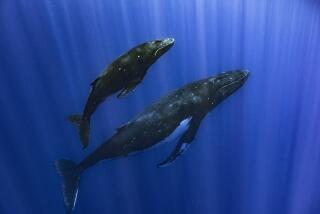BOOK REVIEW : ‘Animal Talk’ Will Find Few Conversant : ANIMAL TALK, <i> by Eugene S. Morton and Jake Page,</i> Random House, $22; 265 pages
- Share via
Shrieks and howls, grunts and roars, burbles and bleats, clicks and croaks: These are only a small sample of the stunning variety of sounds animals produce when trying to make themselves understood. For human listeners, the variety has grown even richer in recent years as advances in microphones and recording equipment have pushed the boundaries of human hearing far beyond where nature set them.
Unaided human ears can distinguish tones through about 9 1/2 octaves (a piano has eight), note authors Eugene S. Morton and Jake Page. With electronic help, scientists can hear, for example, the otherwise inaudible high pipings of bats and deep rumblings of elephants.
But are these noises really “talk”? Are animals actually using language as humans do?
No, say Morton, a research zoologist at the Smithsonian Institution’s National Zoological Park in Washington and Jake Page, a science popularizer. Two things, they say, set human speech apart from animal: first, “human beings are predisposed to human grammar--for example, sentences that have a subject and a verb”; and second, most of the sounds humans produce “are totally arbitrary.”
Every human language has a different-sounding word for man and woman. “It is these qualities,” the authors say, “that give humans the ability to comment on matters that are not present--in space or time or both--an ability denied to other animals.”
But if animals aren’t really talking, then what are they doing with all that noise? To find out, the authors summarily review the last hundred years of research in animal behavior and linguistics, then formulate their own hypothesis to explain animals’ attempts to represent themselves emotionally to other creatures. Boiled down, their hypothesis is that, apart from bats, dolphins and whales, which use sound to locate objects, noisy animals are either claiming turf or raising alarms.
This serious and literate book is nothing if not ambitious, and it includes some fun facts along its resolutely scholarly way. For example, male canaries court females by singing. No surprise there, but the news is that the more elaborate the crooner’s song is--ring-a-ding-ding--the more quickly the female becomes ready to mate.
Male ravens take a contrary approach to wooing. They pretend to vomit at the feet of their female quarry, another technique attributed to certain members of the Rat Pack. But unlike aging Hollywood party animals, the ravens use the gesture to promise they will provide regurgitated food for future young.
Among the book’s many nifty bird facts--the authors co-wrote “‘The Smithsonian Book of Birds”--is that wood thrushes and hermit thrushes can sing two songs at once, by controlling the two sides of their voice box independently.
But it is whales, the authors say, that take the prize for singing. Whale songs, composed of eerie moans, whistles, clicks and even multi-toned chords, can be heard for miles underwater. One humpback whale was recorded producing 22 hours of continuous song.
Unfortunately, such tidbits of animal lore will appear too rarely for most readers. Despite the book’s inherently fascinating subject matter and the frequent sparkle of its prose style, “Animal Talk” suffers from too much abstract theorizing, unleavened with concrete examples from animal life.
The exposition falls too often into intellectual hyperbole, in which every idea is stretched out, looked at from all possible angles, digressed from innumerable times, then finally, reluctantly, abandoned--only to be returned to later and treated similarly, as if for the first time. In brief, “Animal Talk” requires too much patience, dedication and stamina for the slight and unoriginal statements it ultimately delivers.
Also, the book’s narrow focus on the authors’ (presumably Morton’s) hypothesis ignores too many important questions. For one, how do other animal researchers regard Morton’s ideas? Is he a leader in the field or a voice in the wilderness? “Animal Talk” is mute on that point. Perhaps the reader should be grateful, because, to paraphrase 19th-Century American literary wit Ambrose Bierce, the covers of this book are already too far apart.
More to Read
Sign up for our Book Club newsletter
Get the latest news, events and more from the Los Angeles Times Book Club, and help us get L.A. reading and talking.
You may occasionally receive promotional content from the Los Angeles Times.










